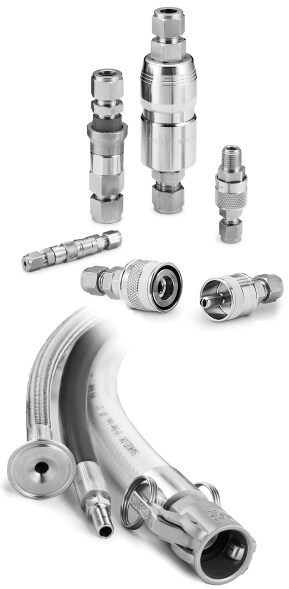Make Flexibility Your Priority
Make Flexibility Your Priority
In last weeks’ blog we discussed What’s in a Hose - the materials of construction, including core, reinforcement, covers, and end connections; the principle benefits of hose; and installation best practices. This week looks at the important question: When Should You Use Hose?
The Convenience of Flexibility
The initial purchase price for hose is more than tubing or pipe, but in a plant environment, there are many places where hose pays for itself very quickly. For example, here are common situations where you could use hose instead of tubing or pipe to reduce costs associated with installation, component replacement, wear or failure, and/or maintenance costs:
- Connections requiring complex tube bending
- Applications with severe vibration
- Temporary connections
- Moving parts
- Parts requiring frequent replacement or servicing
Hose is very convenient. Installing it takes a matter of seconds – minutes at most. That’s markedly different than tubing or pipe. But how do you weigh the convenience against the higher costs for initial acquisition? How do you know when to choose hose over tubing or pipe? In more detail, here are some situations where hose makes the most sense.
When to Use Hose
Connections Requiring Complex Tube Bending
Tubing is much faster to install and replace than hard pipe because it can be bent to precise radiuses. Tube bending is not difficult, but it does require some tools and training. If your technicians do not have tube bending skills, it may be advisable to go with hose. Sometimes a replacement part does not have the same dimensions as the original, and the original section of tubing or pipe does not quite align with the new connections. You can sidestep a potentially difficult or frustrating situation like this with hose.
Applications with Severe Vibration
When vibration is severe and regular, hose can manage the stress better than tubing, especially when high pressures are in play. The frequent vibration – experienced each time a compressor cycles, for example – may stress tubing to the point of fracturing. Before you know it, your system is leaking. In a high-vibration application, a run of hose can dampen vibration between the source and the rest of the tubing assembly. All you need to worry about is choosing an end connection that can handle vibration. For example, Swagelok tube fittings are designed not to leak with vibration.
Temporary Connections
When making temporary connections, hose is very efficient. For example, hose is an excellent choice for water sampling and chemical sampling for analysis. It bypasses alignment issues associated with rigid pipe or tubing, and it can attach with a cam-lock or quick-connect connection. Every time you connect and disconnect with a hose, you are shaving minutes or more off your staff time, as compared to tubing or especially pipe.
Moving Parts
The pneumatic actuators on some large control valves move up and down and therefore require a flexible connection to the compressed air source. There are many such applications in a plant, whether pneumatic or hydraulic, where you need to allow for some movement or flexing, and hose is your best choice for such applications.
Parts Requiring Frequent Replacement or Servicing
In applications requiring frequent maintenance, tubing or hose may be appropriate, depending on the circumstances. Both can connect by way of Swagelok tube fittings, which can be disassembled and reassembled with the turn of a wrench. On gas turbines, for example, metal hoses are customarily employed. Turbine inspections require frequent assembly and reassembly of components, and hoses make this easier, enabling quick access for maintenance personnel. Further, if the hoses need to be changed out, it’s a relatively simple process.
For applications requiring frequent component replacement, ask yourself: Will the replacement component be exactly the same as the one removed? Is there a chance of an alignment issue, which would force personnel to have to bend a new piece for tubing? If so, hose may be the right choice. If not, tubing may be the right choice. In general, hose is a good safeguard against misalignment issues between components.
We Know Hose
At Swagelok Calgary | Vancouver | Red Deer | Medicine Hat |Prince George, we know hose. Whether it be product selection, or application expertise, we have the answers to your questions. For more information on how hose can enhance your performance and reduce maintenance costs, get in touch with our team today.
Explore Swagelok Hose Products
Swagelok Hose Advisory Service


